70 Years of Hanmo, Painting in Jiangxi-The 7th Jiangxi Art Festival Chinese Painting Exhibition
Organizers: Propaganda Department of the Jiangxi Provincial Committee of the Communist Party of China Jiangxi Provincial Department of Culture and Tourism
Organizer: Jiangxi Painting Academy, Jiangxi Provincial Art Museum
Exhibition period: 2019.12.30—2020.2.15. (Closed on New Year's Eve to the third day of the year)
Exhibition location: South Hall, 2nd Floor, Jiangxi Art Museum (No. 266, Bayi Avenue, Nanchang)

For painters, painting is not necessarily for telling stories, but all paintings must have stories.
—— 策展人 雷子人
"The natural treasures of things, the outstanding people and the great spirits", the poems extolling the ages in the Preface of the Tengwang Pavilion are the basic impression of ordinary people in Jiangxi. Jiangxi is the name of the province because of Emperor Xuanzong’s establishment of Jiangnanxidao. It is also called "Jiangyou" because "Jiangxi is viewed from the north, Jiangdong is on the left, and Jiangxi is on the right." Since ancient times, there has been "a state of justice, white crane fish and rice." The reputation of "the country". Unique dialects, academies, Zen, Taoism, rice cultivation, merchants, bronze, ceramics, Nuo noodles, Kanyu, Chinese medicine, and tea culture have formed Jiangxi and its surrounding areas into a unique Jiangyou culture, which is in the history of Chinese civilization. The above has a pivotal position.
What was Jiangxi like in the past, and what was its customs and spiritual outlook? Through the exhibition, the editor wanted to find the stories and culture of old Jiangxi in the paintings.

Millennium Jiangcheng is still here today
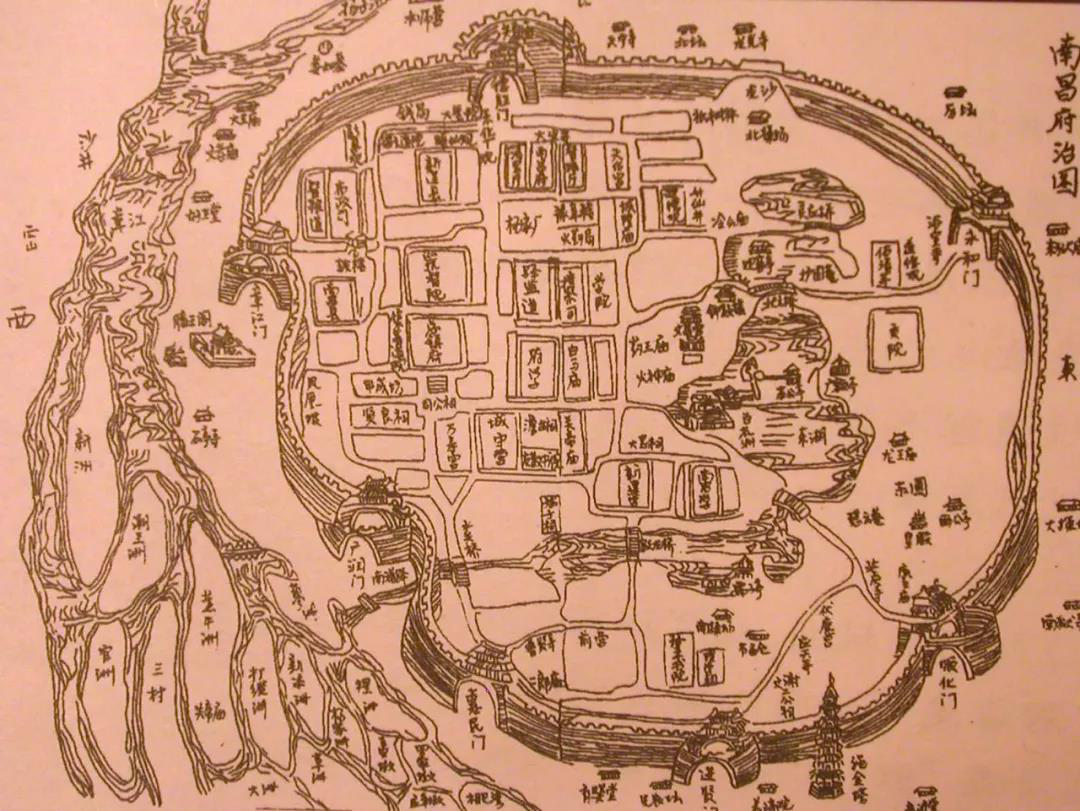
In this ancient map of Nanchang Mansion, we can understand that Nanchang in ancient times was very different from today. Buildings such as the Tengwang Pavilion and Shengjin Pagoda are located outside the city wall; within the city wall, academies, academies, tributes, temples, barracks, yamen, etc. are all available; the lakes in the city are connected with the river outside the city; the East Lake and Baihuazhou are connected with the thousand years later. Today is no different.
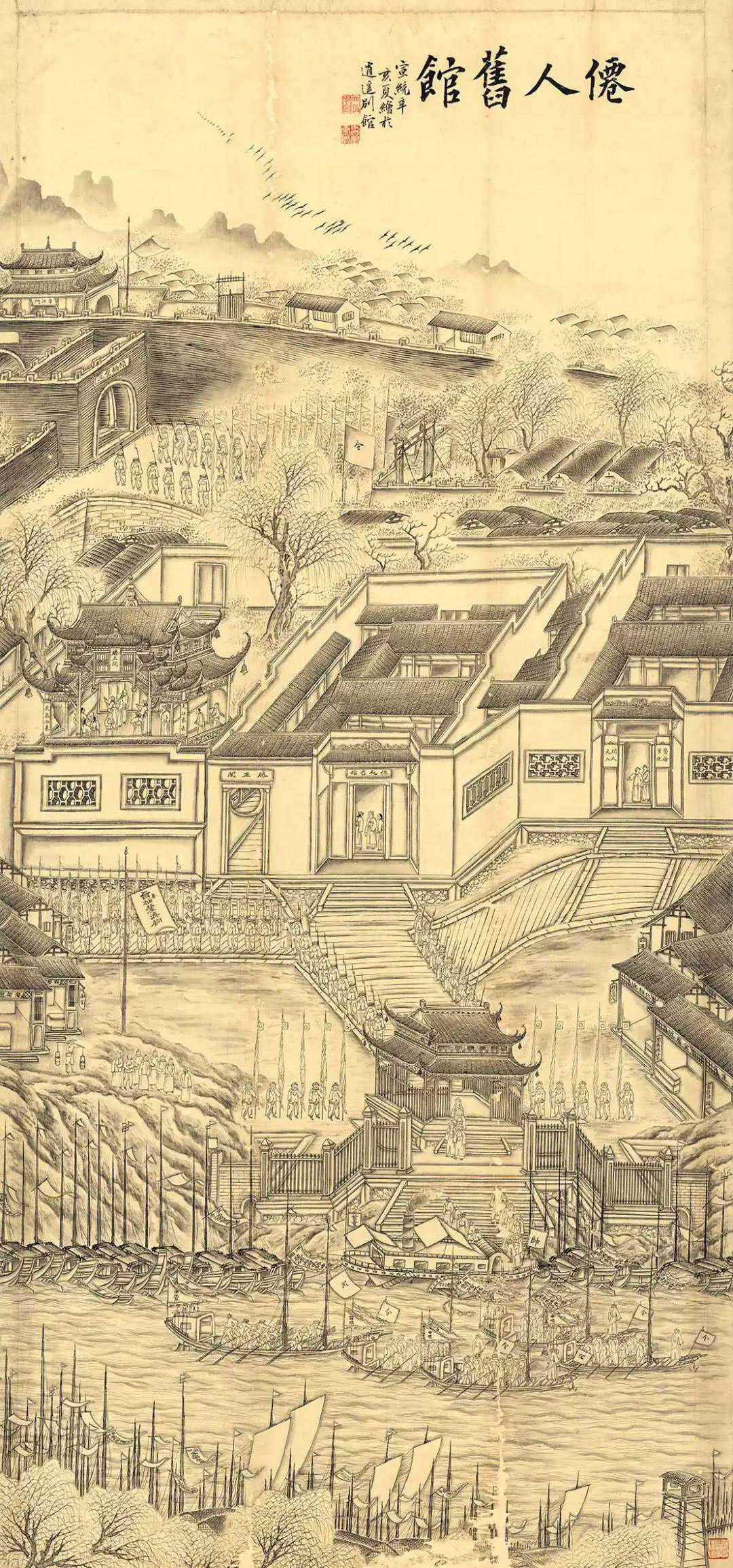
"Map of Famous Relics of Jiangcheng·Tengwang Pavilion" Zhang Yanqian, Yuan Daichun, 1911
In the first year of Xuantong, the Qing government suffered from internal and external difficulties, and the people were exhausted. Although the Tengwang Pavilion, which was destroyed in the last years of Guangxu, was rebuilt, its scale is not as good as before. It can be seen from this painting that the Tengwang Pavilion standing outside the city is relatively simple, and there are poems and paintings by dignitaries and nobles, or talk about it. The flags on the pier are fierce, and the ships of the Jiangxi Inland River Division are equipped with artillery. The soldiers outside the city gate lined up neatly and the atmosphere was tense. Although the city of Nanchang has a large number of soldiers and strong boats and guns, it still cannot stop the rolling wheels of history. This year was the third year of Emperor Xuantong of the Qing Dynasty. On October 10, the Wuchang Uprising started, the vigorous Xinhai Revolution broke out, and on October 23, Jiangxi Jiujiang and Nanchang recovered. The situation was turbulent, and the Tengwang Pavilion was eventually destroyed by warlords in 1926.
During the period of the Republic of China, architect Liang Sicheng and his disciple Mo Zongjiang drew eight "Sketches for the Reconstruction of the Tengwang Pavilion" based on the old Song paintings of the "Tianlai Pavilion", including one color perspective drawing, and seven plan, elevation and cross-sectional views. After the founding of New China, the reconstruction was completed in 1989 after several turns.
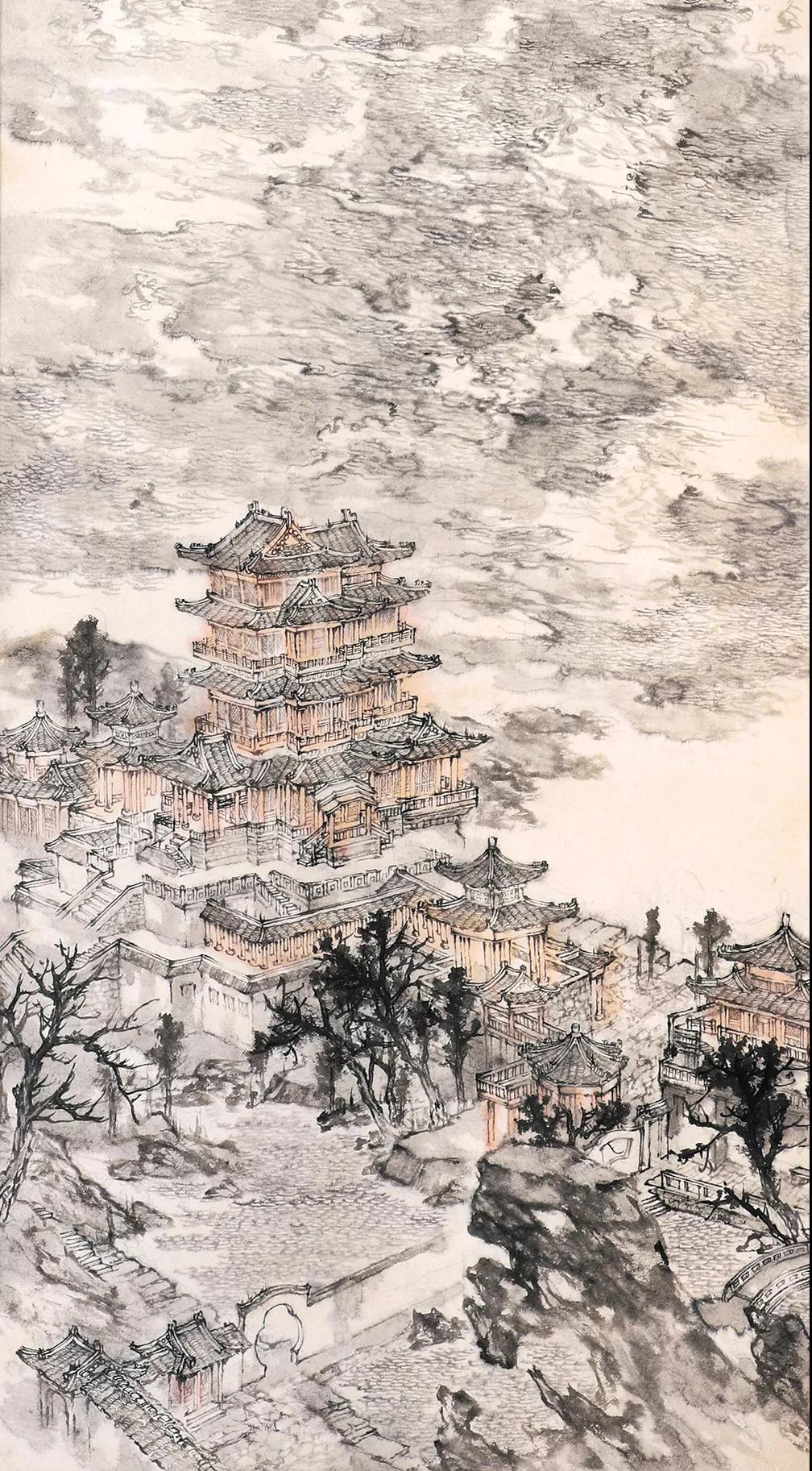
"Autumn Water, One Color, Partially" Zhang Jinmei 2017
Today, the majestic posture of this millennium-famous building stands on the riverside, and tourists from the past are in droves. People climbed up here to look into the distance, admire the magnificent scenery of "falling clouds and lonely birds flying together, and the autumn waters are the same color", and feel the life ideals and romantic feelings of literati in the Tang and Song Dynasties.
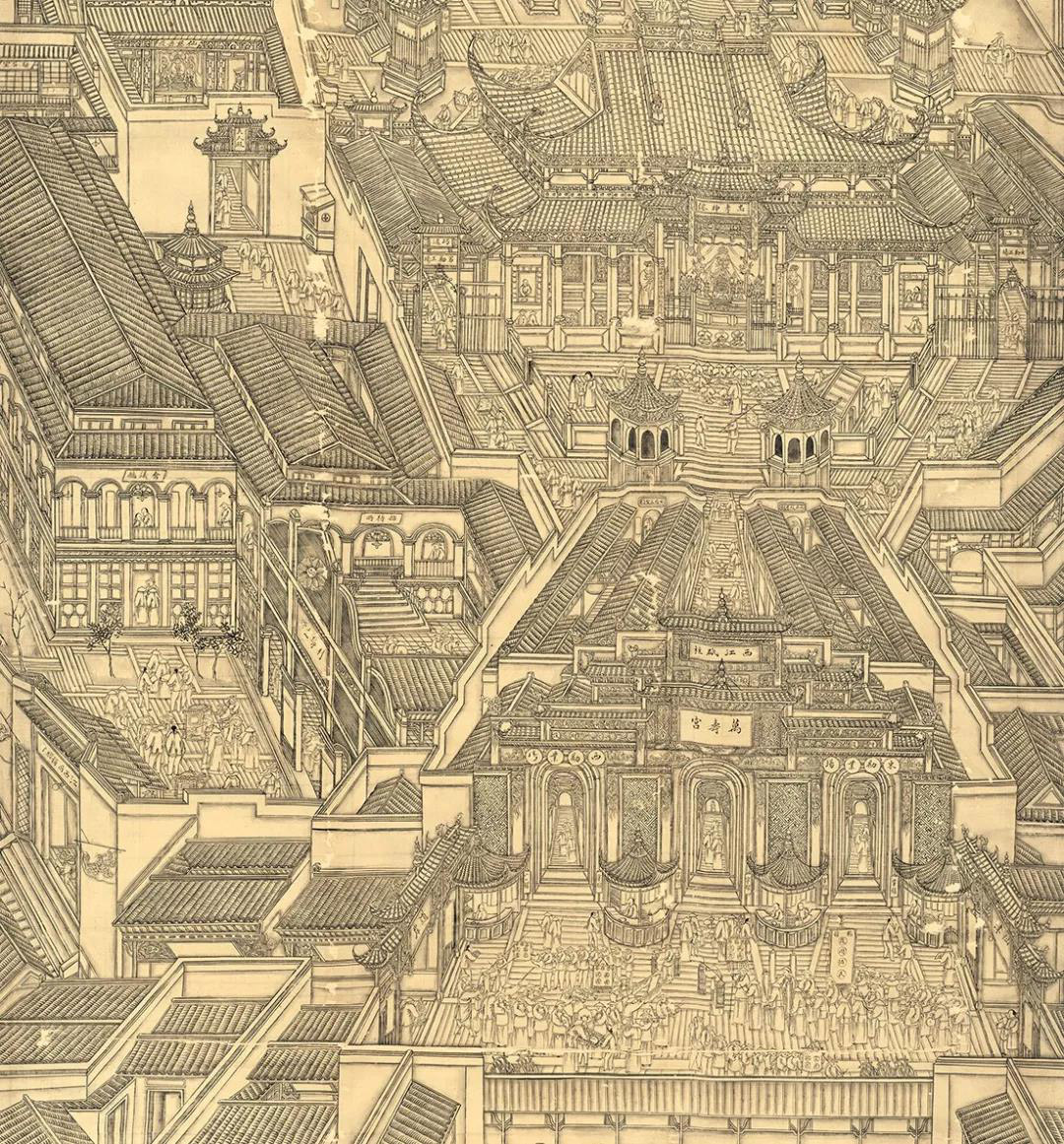
"Jiangcheng Famous Relic Map·Longevity Palace·Part" Zhang Yanqian, Yuan Daichun, 1911
This picture shows the Nanchang Tiezhu Wanshou Palace after the renovation in the autumn of Ding Weinian (1907) in Guangxu. This historic religious and cultural building is located in Cuihua Street in the Guangrun Gate of the old city of Nanchang. The prosperity of logistics caused by water and land terminals and transportation hubs, combined with the fanatical beliefs of Xu Zhenjun in the Yangtze River Basin, has made Wanshou Palace a cultural gathering place with Jiangxi characteristics. Throughout the ages, it has been the residence of travelers and chambers of commerce. The editor's impression of Nanchang Wanshou Palace is that of criss-cross narrow streets and trade markets where merchants gather. This picture tells that the former Wanshou Palace was not only equally prosperous, but also a cultural district with a long history. Unfortunately, the original site was demolished during the Cultural Revolution. Fortunately, the Nanchang Municipal Government is stepping up the restoration of the original site of the Wanshou Palace, and the Tiezhu Wanshou Palace will soon regain its original brilliance.

"Map of Jiangcheng Famous Relics·Yuzhang Academy·Parts" Zhang Yanqian, Yuan Daichun, 1911
Jiangxi can be said to be the birthplace of Chinese academy culture, and it has a pivotal position in the history of our country. Yuzhang Academy, founded in the Southern Song Dynasty, is one of the four major academies in Jiangxi. Huazhong Fuxue is Yuzhang Academy, which was the highest government-run institution in Jiangxi at that time. Although the Qing court abolished the imperial examinations in 1905, there was a lot of traffic at the gate of the painting academy, and students wandering around the academy, presumably the academy has been converted into a new school. After entering the Republic of China, the Industrial School, formerly Yuzhang Academy, was renamed "Jiangxi Intermediate Industrial School" and assumed the social responsibility of cultivating engineering talents for the motherland. After the founding of the People’s Republic of China, Yuzhang Academy was upgraded to "Jiangxi Institute of Technology" and the campus was moved outside the city, which is the predecessor of today's Nanchang University. The original site of the Academy is now located in the No. 18 Middle School of Nanchang, Shuyuan Street.

"Map of Famous Relics of Jiangcheng·Nanzhou Flower Island" Yuan Daichun 1911
This piece of Baihuazhou in "Nanzhou Flower Island" created in 1911 seems to be more lively. Many people cruise the lake to enjoy the rest time. The western-style building below the painting is very unique, with the words "Jiangxi Exhibition Hall" written on it. Plaque. Visitors to the surrounding areas include both the Qing court people with pigtails and progressive people in dresses. The city seems to be a prosperous, lively and peaceful scene.

"Hundred Flower Island" Qu Tao 2006
Nowadays, Baihuazhou is an oasis in the center of Nanchang's prosperous city, bringing a moment of leisure to the tense urban rhythm. Citizens mostly spend leisure time in the park and go boating.

Liaoyuan sparks out of Ganpo
Speaking of Jiangxi, I have to mention that the Chinese Communists led the people to establish a large revolutionary base here. Here, the Communist Party of China, represented by Mao Zedong, combines Marxism-Leninism with the practice of the Chinese revolution, which has nurtured the brilliance of the Communists’ faith and the revolutionary spirit of China.
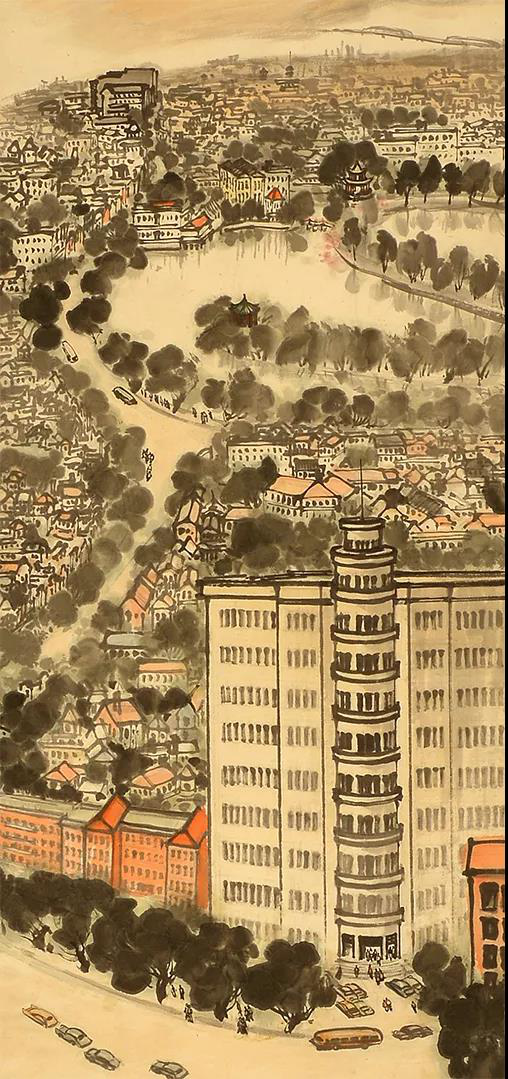
"Four Screens of Jiangxi Scenery·Nanchang·Part" Yan Ming 1961
On August 1, 1927, a shocking shot in Nanchang city opened the prelude to our party's independent leadership of armed struggle and the creation of a revolutionary army. A massive wave of revolution proclaimed the firm stand of the Chinese Communist Party to carry the revolution to the end.
The heroic city of Nanchang in the painting is peaceful and lively. Obviously, the peace and stability after the founding of New China enabled the people to live and work in peace and contentment, and the city developed steadily. There are lots of cars and customers in front of the department store. The beautiful scenery of East Lake is still there, and there seems to be people fishing by the lake. In the distance, Bayi Bridge is majestic and straight, disappearing into the colorful clouds.

"The Four Screens of Jiangxi Scenery·Jinggang Mountain" Yan Ming 1961
On July 27, 1927, Mao Zedong led the Workers’ and Peasants’ Revolutionary Army for 38 days and traveled more than 1,000 miles to reach Ciping, the center of Jinggangshan, and planted the red flag on Jinggangshan.
In the paintings of Mr. Yanming, the new scene of Ciping after liberation is depicted with a unique personal style and different visual angles. The town is rural and neat, and the center road has been completed. You can clearly see the green belt in the center of the road and the cars driving on it.
Today, Ciping Town has become a beautiful park and mountain city. Tourists who come to Jinggangshan will start their journey to the cradle of revolution with this as the center.

"Four Screens of Jiangxi Scenery·Ruijin·Part" Yan Ming 1961
Ruijin, the old red capital, was the residence of the Party Central Committee during the Soviet Area of the Communist Party of China, the birthplace of the Provisional Central Government of the Chinese Soviet Republic, and the starting place for the central leadership and the Red Army to begin the 25,000-mile Long March. Today, Ruijin still attracts the eyes of countless Chinese people tracing their roots, looking for figures of great men and traces of battles of martyrs.
In the painting, the Yeping Red Army Memorial Tower in Ruijin is solemn and solemn. The spring breeze in the city has arrived, peach blossoms are in full bloom and the greenery is full.

Only by being in this mountain
Lushan is well-known in the world for its majesty, oddity, danger and beauty, and is known as "Kuanglu's wonderful show is the best in the world". In addition to the beautiful scenery, the poems of literati and poets, the research and thinking of Bailudong Academy, and the footprints of great men are enough to make people forget this.

"Four Screens of Jiangxi Scenery·Lushan" Yan Ming 1961
In the Lushan Mountain in the painting, there are buses from the mountain road to the mountain, and there is a small pavilion on the steep mountain peak in the center for tourists to rest. The mountainside is slightly slower, and a peaceful town is built on the mountain, which should be Guling Town. Guling is derived from the English "cooling", which means "cool". It was named after the British missionary Li Deli. The earliest "real estate developer" in Lushan has almost exhausted his life to develop the Lushan villa complex with a design that combines nature and architecture. There were as many as 560 villas in their heyday, and thousands of people from 15 countries around the world lived here. The higher part of the town in the painting is probably the villa group. There seems to be a small pavilion on the upper right side of the town, and there seems to be a lake next to it. The editor guessed that it might be the flower path at that time. And the five understatement in the distance should be Wulaofeng.

The kiln keeps on fire in Jingdezhen
The ceramics of Jingdezhen made Jiangxi famous all over the world. In ancient times, there were many porcelain kilns in Jingdezhen. In addition to official kilns, there were countless folk kilns and craftsmen. The porcelain made is "white as jade, as thin as paper, as bright as a mirror, and sound like a chime". Along the "Silk Road" on land and sea, "traveling in nine regions and spreading abroad" contributed to the enrichment and development of world culture. Significant contribution.
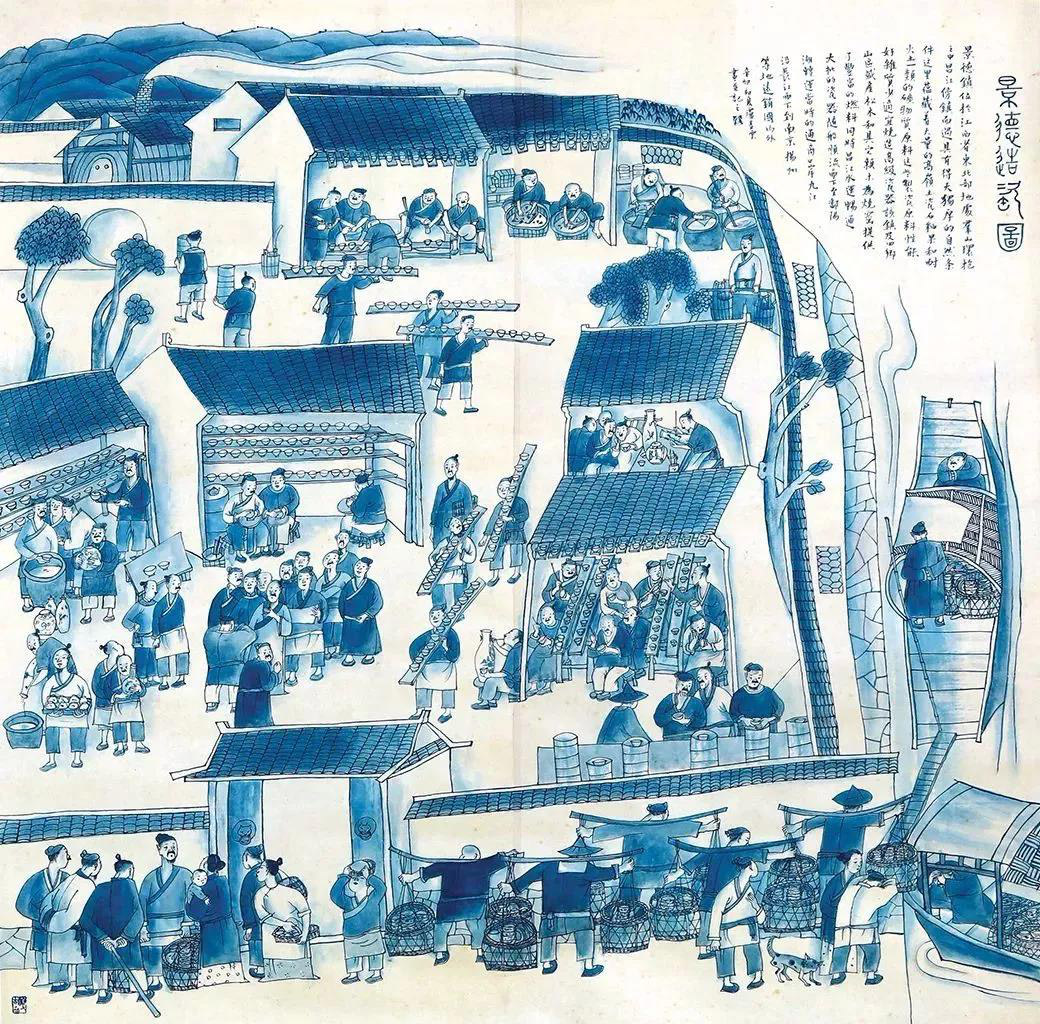
"Porcelain Painting in Jingde" Lu Qingyun 2011
After the steps of earth cutting, smelting, making saggers, tire repairing, glazing, and painting were completed, the businessmen outside the porcelain factory could not wait for a long time, and quickly ordered the porters to carry the porcelain onto the cargo ship. These exquisite porcelains will flow down the Changjiang River to Poyang Lake, and then be transported to the commercial port of Jiujiang, and then transported along the Yangtze River to Yangzhou and Nanjing. Eventually they will be exported overseas, and Chinese culture will be spread to the world with these exquisite vessels.
As a representative and symbol of the "country of porcelain", Jingdezhen's porcelain-making tradition has been preserved to this day, and the pursuit of ceramic art is constantly improving. The strong artistic atmosphere has attracted countless artists to this kiln-fired city, and the special group "Jing Piao" and their unique culture have been nurtured.

Dancing the happy bench dragon
Many villages in Jiangxi have the custom of dancing the bench dragon on the Lantern Festival. This kind of folk activities that have lasted for centuries are common in the southern provinces, entrusting the diligent and intelligent farmers with their hopes for a smooth and auspicious year in the coming year.

``Hongzhou Scenic Spots·Parts'' Zhou Jingshan 2019
In the "Scenic Scenery of Hongzhou" created by Mr. Zhou Jingshan, there is such a dragon dance team. The team enters Nanchang from Yonghemen, and there are merchants selling firecrackers and Buddha statues beside the street. According to the map of Nanchang Mansion, the location of Yonghe Gate may be at the east end of Minde Road. You can go to Youmin Temple shortly after entering, and it is reasonable to see merchants selling firecrackers and Buddha statues. The banner in front of the dragon's head reads the words Li Village Bench Dragon, which is probably the dragon dance team in Li Village, West Lake, Jinxian County. It is understood that the village still retains the custom of dragon dance, and the inheritors of the skills of making dragon heads are also in this village. It can be seen that the painter has conducted in-depth textual research and research on Jiangxi folk culture when creating.
The above essay is just a comment from the editor. If you have any mistakes or omissions, please leave a comment. I am very grateful.
There are more classic works on the scene of "70 Years of Hanmo·Jiangxi Painting-The Seventh Jiangxi Art Festival Chinese Painting Exhibition". Each painting will bring unique feelings to different people. Please find familiar past through them and listen to the wonderful stories brought by artistic language.
Part copy quoted from "River fort Figure REVIEW" Author: Zhong Liwen, should Chen Jie
Chapter 1: The old Zeng Jing's exhibition works catalog
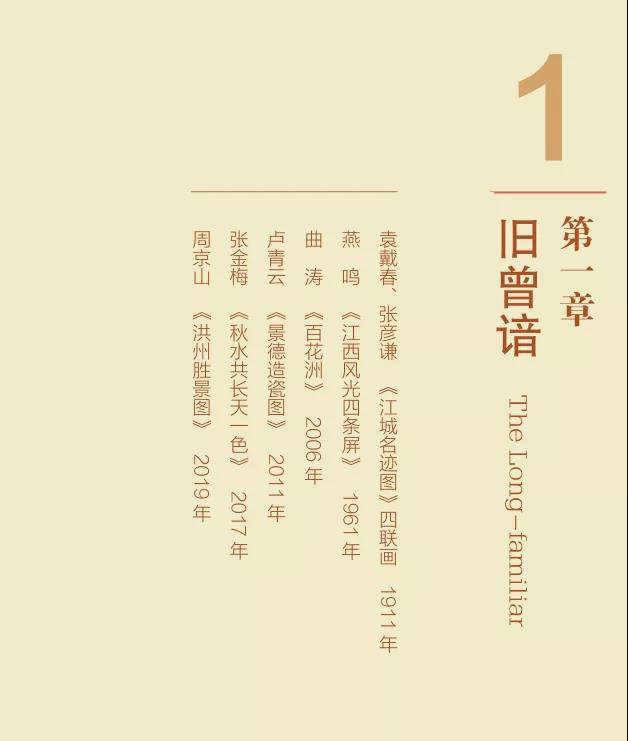
开放时间:9:00-17:00 周一闭馆(法定节假日除外)
详细地址:江西省南昌市西湖区八一大道266号(八一广场西侧)
乘坐地铁1、2号线至八—广场站(5号口出站),出站后由中山路往
八—大道方向步行,至八—大道后右转(向南)行200米即到本馆
 江西省美术馆微信公众号
江西省美术馆微信公众号